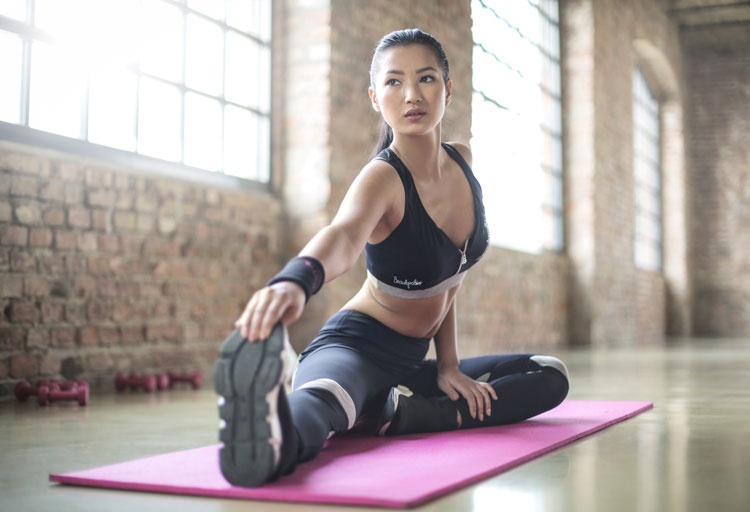12 Best Ayurvedic Treatments for Acne Due to Hormonal Imbalance
Acne is a frustrating skin condition that affects millions of people. Many factors may contribute to an acne problem. One of the most common of these is a hormonal imbalance. The situation is all-too-familiar to teenagers everywhere. As their hormones wildly fluctuate, they experience acne and other symptoms. However, hormonal imbalances can occur to anyone and at any age. A hormone imbalance may be behind many cases of adult acne. To battle against such, miracle tools such as a face steamer can be an ultimate life-saver.
Menstruation and menopause have definite effects on hormone balances, and many women see an uptick in acne problems during these times. When people experience troubling symptoms, they may look to a natural treatment method. This is because many treatments that are recommended by Western medicine come with troubling side effects. Using herbs and other natural substances may deliver the same beneficial outcomes without the side effects.
Here is a guide to the 12 best Ayurvedic treatments for acne.
1. Turmeric

Turmeric is so much more than a delicious herb that can be added to a wide variety of dishes. Ayurvedic healers have long used it to treat the signs and symptoms of acne.
This is because turmeric is loaded with a substance called curcuminoids. Frequently referred to simply as curcumin, this substance is an antioxidant and an anti-inflammatory. Additionally, studies suggest that the herb has antibacterial and antimicrobial properties (1).
Curcumin protects skin against the underlying causes of inflammation. These underlying causes may include bacteria on the skin’s surface and the buildup of excessive oil. In response to oil and bacteria, the body’s immune system is triggered, causing inflammation.
Turmeric is effective when used both internally and externally. Consider purchasing an organic turmeric tea to help with cleansing the body from the inside. Then, mix turmeric with a bit of yogurt and honey to make a face mask. Leave the mask on for up to half an hour before washing away with water. Use at least once per week for best results.
Try it here: Organic Turmeric Curcumin with Black Pepper, Boswellia, and Ginger
2. Coriander
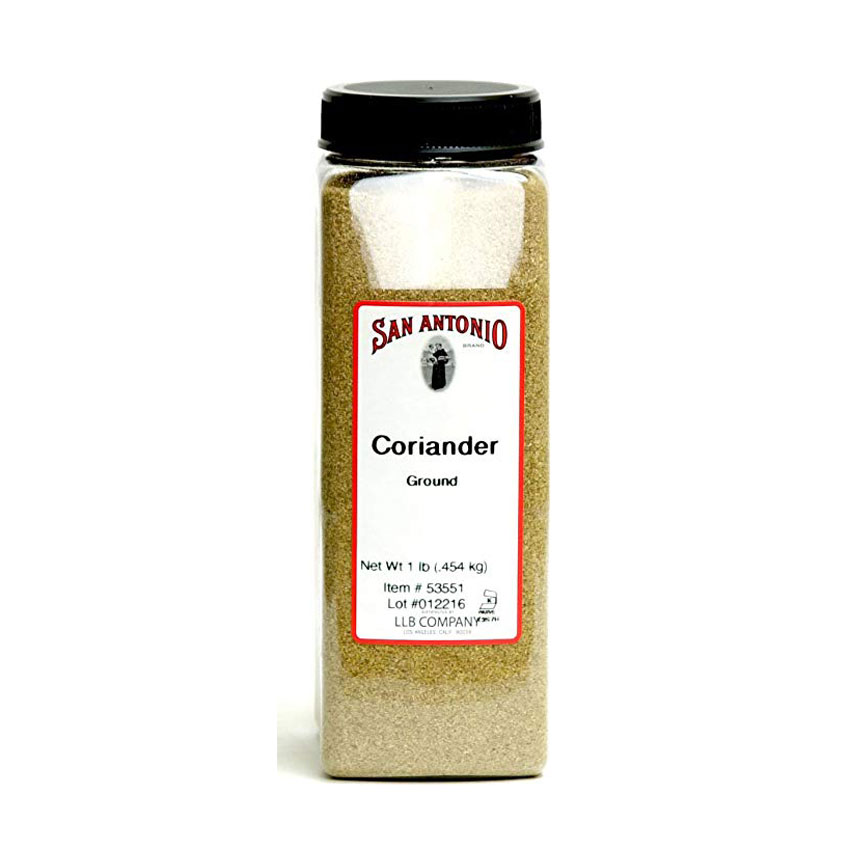
This herb, which many people recognize as cilantro or hara dhaniya, is packed with good ingredients like beta carotene, vitamin C and antioxidants. Antioxidants such as those found in coriander prohibit free radicals from moving throughout the body, which slows down the aging process.
Coriander further boasts anti-inflammatory properties in addition to being antiseptic and antibacterial. Additionally, it’s a disinfectant, so it becomes clear why this herb can be a miraculous acne treatment.
In a study, researchers concluded that coriander may be a safe and effective alternative to prescription medication treatments (2).
One remedy suggests combining ground coriander with lemon juice. When applied to the skin, this mixture calms and heals acne. Another treatment recommends placing one teaspoon each of coriander, chamomile and lemongrass in a pan. Add one cup of boiling water, then let the mixture cool for one hour. Pour the concoction into a blender, blending on high until it becomes a paste. Smooth this on acne-prone skin, and leave in place for about 20 minutes. Rinse away with clean water. Use a cleansing mask at least once or twice each week.
Try it here: Premium Ground Coriander Powder
3. Kutki

Long recognized as an herb capable of detoxifying the liver, kutki also is recommended for acne because of its cleansing and cooling properties. The rhizomes, leaves, bark and roots all may be used for their curative properties. However, it is the rhizomes that are most highly prized.
Kutki was recognized for its ability to have an ameliorating effect on numerous inflammatory conditions in a massive study of plant-based healing techniques (3), suggesting that kutki is a valuable weapon in the fight against chronic acne.
One method of using this treatment suggests supplementing the diet with kutki by mixing a half teaspoon of it in a hot cup of water each morning. You may even mix a half teaspoon of turmeric into the cup so that the two herbs can work together. If the kutki makes this drink too bitter, consider adding a dollop of honey.
Try it here: Kutki Vegetarian Capsules
4. Shatavari

This amazing herb has many healing uses, particularly for women. In fact, it has long been used as an antidote to premenstrual symptoms and all of the uncomfortable side effects that come with menstruation. Accordingly, Shatavari helps to balance the hormones, leading to fewer acne breakouts.
Sometimes referred to as wild asparagus, Shatavari is believed to be an adaptogenic substance that supports adrenal health (4). Accordingly, Shatavari’s ability to correct hormonal imbalances should alleviate the symptoms of acne.
Traditional ayurvedic practitioners suggest mixing together Shatavari, kutki and Guduchi in powder form. Three times per day, the one-quarter teaspoon of the mixture is placed under the tongue, then swallowed with water.
Try it here: Banyan Botanicals Shatavari Powder, Certified Organic
5. Tulsi
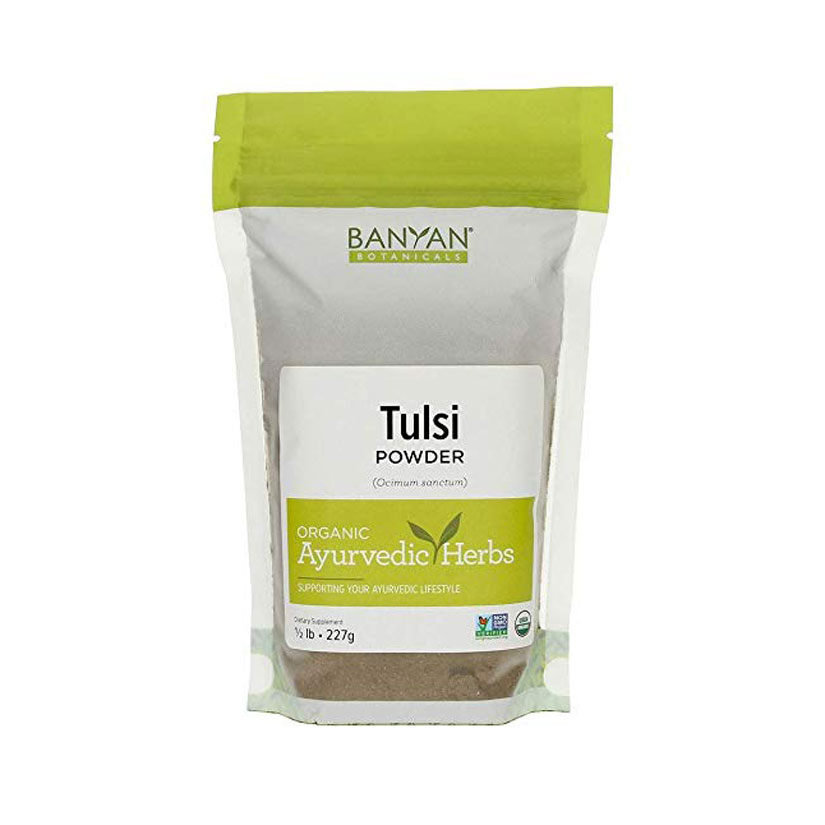
Frequently also called holy basil, tulsi is loaded with anti-bacterial properties. This means that applying it to the skin helps to get rid of much of the bacteria that cause acne. Traditional teaching suggests that this herb also may be able to promote cell renewal, leading to the lightening of acne scars. With regular use, this will improve overall skin tone.
Ayurvedic use of tulsi also indicates the herb’s usefulness for treating blackheads and whiteheads when it is used as an exfoliant. Tulsi further is thought to have anti-inflammatory qualities that help to reduce the redness, swelling and irritation that often are associated with acne. Studies suggest that Tulsi can have incredible healing properties for people who are fighting acne (5).
Tulsi may be used by itself or in combination with other herbs for acne treatment. Markets specializing in natural healing and Ayurvedic techniques typically sell tulsi powder. Alternatively, it is possible to obtain fresh tulsi leaves. These can be washed and then set out in the sun for three or four days to dry. When completely dry, the leaves are ground to create a powder.
Mix the powder with just a bit of water to form a paste that can be applied to the skin. Leave the paste in place for 15 to 20 minutes before rinsing away with water.
Try it here: Banyan Botanicals Tulsi Powder, Certified Organic
6. Moringa

It may seem counterintuitive to use an oil to combat acne, but moringa is so low on the comedogenic scale that it actually dissolves the excess sebum on the skin. Accordingly, moringa purifies the skin and stops it from absorbing germs and dirt. The key ingredient in Moringa is linoleic acid, which is known to be an important defense against acne breakouts (6).
Almost any part of the moringa plant may be used for healing purposes, and it doesn’t have to be in oil form. However, this is its most common form for fighting acne. Moringa also is known for its anti-inflammatory properties and its ability to reduce the signs of aging.
One treatment method involves using the leaves of the moringa with a bit of water to make a paste. Smooth it on as a face mask, leaving on the skin for 15 to 20 minutes before rinsing.
Try it here: MAJU’s Organic Moringa Powder
7. Indian Gooseberry

You already may be familiar with this herb as amla. Frequently, it is used to combat the signs of aging or to correct problems with the hair and skin. What makes it so powerful?
Indian gooseberry naturally contains far more vitamin C than an orange. When compared to the powerful acai berry, Indian gooseberry has double the antioxidant content.
Because of these properties, Amla is used on the skin to get rid of dark marks, such as scars that result from acne. At the same time, it combats acne-causing bacteria on the surface of the skin.
While you’re using Indian gooseberry to fight acne, you’re getting additional anti-aging benefits. The antioxidants in the fruit protect your skin from free radicals, toxins that permeate the skin to cause fine lines, wrinkles and other problems. Scientific evidence supports the suggestion that Amla has incredible anti-aging properties (7).
For the treatment of acne, mix amla powder with yogurt and honey to make an all-natural face mask. Leave it in place for 15 to 20 minutes, then rinse it away with clean water. If your skin is excessively oily, try mixing amla powder with rosewater. Apply this to the skin, leaving it in place until it is completely dry before washing away with water.
Try it here: Organic Alma Powder, 100% Raw from India
8. Ashwagandha

Traditional healers have long relied on ashwagandha to correct hormonal imbalances. As a result of this treatment, many patients report a significant reduction in acne breakouts. Additionally, ashwagandha is known to help the body cope with stress, which may be another factor behind acne-prone skin. This herb’s ability to fight acne on two levels makes it particularly valuable.
Among ashwagandha’s merits are its powers as an anti-inflammatory and an antibacterial agent. It heals the redness and irritation that frequently accompany acne, and it even helps with treating wounds.
As an adaptogen, ashwagandha contains withanolides, a compound that does amazing things to regulate the adrenal glands and control inflammation and stress. Other components found naturally in ashwagandha include glycosides, flavonoids, phenols, saponins and alkaloids, all of which support the healthy functioning of the endocrine system and therefore help to combat acne breakouts. Scientific research continues to suggest even more uses for ashwagandha (8).
To treat acne, ashwagandha may be used both internally and externally. Add some ashwagandha powder to a glass of milk, and drink it each day. Use the fresh leaves of the plant or the powder mixed with lime juice or honey on the skin each day to see the best results.
Try it here: Banyan Botanicals Ashwagandha Powder, Certified Organic
9. Neem
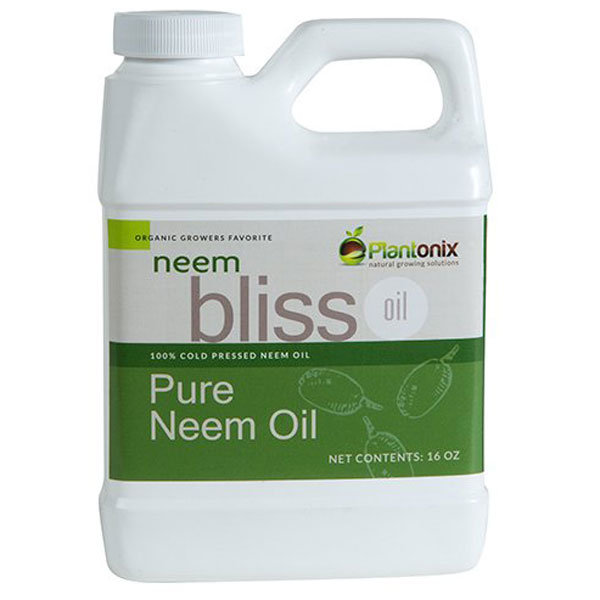
This antibacterial herb is a popular ingredient in all sorts of facial skincare products, including soaps and moisturizers. These products can be incredibly helpful for some people. However, there may be better delivery methods that guarantee improved results.
Neem’s ability to fight harmful bacteria is what makes it especially effective against acne. For instance, components in neem are quite similar to those contained in salicylic acid, which is commonly used in acne treatments. It may be taken in the form of tablets or capsules for the purification of the blood. Like many so-called blood purifiers, neem is an anti-inflammatory and an antibiotic, two characteristics that make it helpful in the fight against acne. Scientific studies appear to support this use (9).
Try it here: 100% Pure Cold-Pressed Organic Neem Oil
10. Triphala
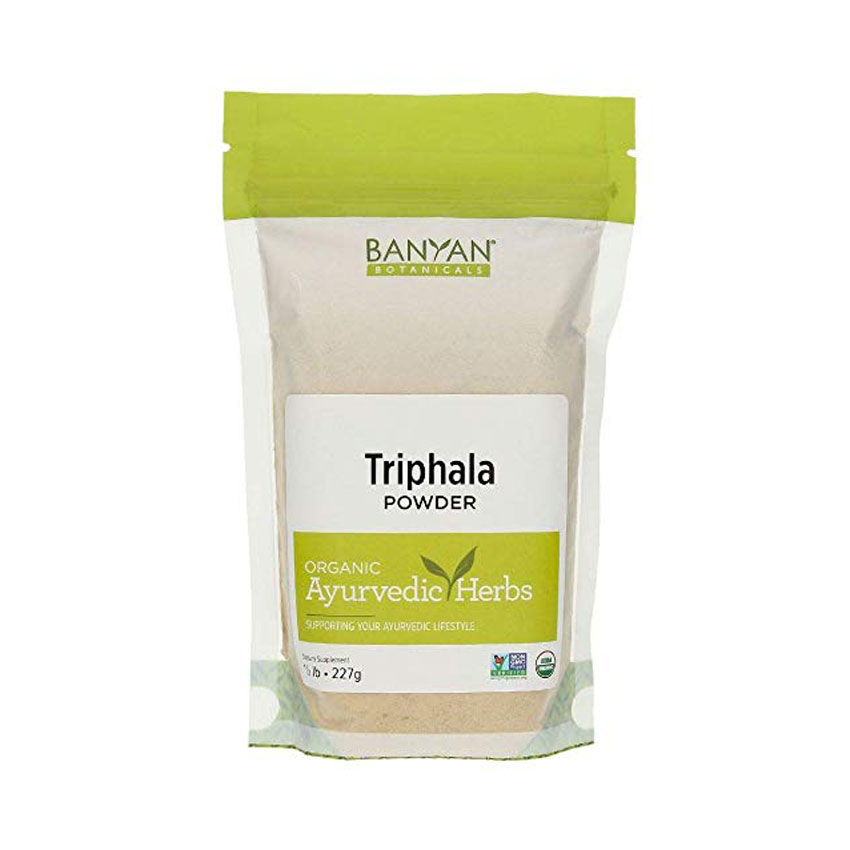
This remedy is recommended by many practitioners because it assists with hormonal imbalances. At the same time, it is instrumental in supporting proper liver function and aiding healthy digestion (10). Why is this important? Because poor digestion can be the root cause of many problems, including hormone imbalances.
Triphala is typically taken in tablet or capsule form, and it is a combination of the powders of three fruits, which are Haritaki, Bibihitaki, and Amalaki. However, Triphala also may be taken as a tea. This is thought to allow the user to taste all of the flavors in the supplement, thereby stimulating the digestive process and allowing Triphala to reach maximum effectiveness.
Try it here: Banyan Botanicals Triphala Powder, Certified Organic
11. Fennel

The long history of Indian and Chinese medicine relies upon fennel as an acne treatment. Like many of the other herbs on this list, fennel possesses inherent antibacterial and anti-inflammatory properties (11). Accordingly, many people have used it to balance hormones and combat acne breakouts.
Fennel may be used as part of a skin-cleansing infusion to unclog pores and remove excess sebum. Make the infusion by throwing one tablespoon of fennel seeds into a pot of hot water. Let the concoction steep for 20 minutes before adding two drops of tea tree essential oil. Store the mixture in a glass bottle and use it regularly for cleansing acne-prone skin.
Try it here: Best Naturals Certified Organic Fennel Seeds Powder
12. Giloy (Guduchi)

Sometimes also called Guduchi, this herb is a natural acne treatment because of its detoxifying effects. In addition, this substance helps to relieve stress and boosts the immune system.
Scientific studies suggest that giloy is a powerful anti-inflammatory that also boasts antimicrobial characteristics (12).
Practitioners suggest drinking between 30 and 50 milliliters of giloy juice each day. Alternatively, it is advisable to mix a one-quarter teaspoon of Guduchi with a one-eighth teaspoon of neem and a one-eighth teaspoon of turmeric. This mixture is used as a face mask three times per week.
Try it here: Banyan Botanicals Guduchi Powder, Certified Organic





